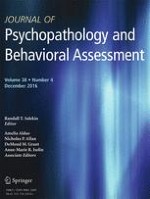20-05-2016
Validation of the Five-Factor Model Personality Disorder Prototype Counts with the Personality Assessment Inventory
Gepubliceerd in: Journal of Psychopathology and Behavioral Assessment | Uitgave 4/2016
Log in om toegang te krijgenAbstract
Five-factor model (FFM) personality disorder (PD) prototype scores drawn from the revised NEO-Personality Inventory (NEO-PI-R) have demonstrated strong convergent validity with clinical measures of PD (Miller in Journal of Personality, 80, 1565–1591, 2012). However, an examination of the relations between the Personality Assessment Inventory (PAI; Morey 1991), which is widely used in personality assessment research, and the FFM PD prototype “count” method, has not been conducted. The present study examines the convergent validity of the FFM borderline, antisocial, and psychopathy prototype counts with the Borderline Features (BOR) and Antisocial Features (ANT) full scales and subscales from the PAI. Furthermore, the BOR and ANT scales are correlated with all 30 NEO-PI-3 facets to empirically evaluate the rationally-selected facet scales used in the borderline, antisocial, and psychopathy PD counts. Five hundred thirty-five undergraduate students completed both the NEO-PI-3 and the PAI. The PD counts demonstrated strong convergent and discriminant validity with the PAI clinical scales. Facet-level analyses generally supported the structure of the PD count formulas, and the exceptions align with previous evidence that the Competence, Dutifulness, and Self-Discipline facets (from the Conscientiousness domain of the FFM) associate strongly with the BOR scale.
